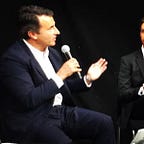The Future of Banking
Four Scenarios
The fact that the financial services industry, and especially banking, is going through the greatest disruption since the arrival of computers in the 60s is now universally accepted. The advent of digital technology and more importantly its adoption by customers is changing the fundamentals of the business. This is not just the arrival of a new channel, it’s a rethink of how business is conducted, how customers are engaged with and how financial products are manufactured.
So the big question is after the “Big Disruption” has had its impact what will the future look like? Endless scenarios could be offered, but I thought it would be worthwhile to sketch four scenarios of the Bank of the Future 10 years from today:
Scenario 1 — The Better Bank
The digital revolution has run its course and almost all customers see digital as their main engagement mode with their bank. The incumbent big banks realised the opportunity and reshaped their businesses to meet the new digital requirements. They restructured their IT platforms and processes, delivered new propositions internally and through partnerships. But most importantly they made the most of their key assets: They were able to retain most of their customers, retrained their people to become more digitally literate, repurposed their branches to address new requirements and leveraged the trust of their customers to become a better bank for the future. The banking market is still largely owned by them. Good examples of possible winners in this scenario include: Wells Fargo, Société Générale, Barclays, Lloyds and many more.
Scenario 2 — The New Bank
The incumbents were unable to survive the digital disruption. They were not able to match the needs of their customers. These left in droves to go to the new challenger banks. These are new full service banks built for the digital age. They provide the services similar to those of the old banks but they do it faster, cheaper and better that they ever could. The core platforms and associated processes are designed to make the most of new technologies and they address regulation and customer need much better the traditional market leaders could. They re-built the banking industry for the future. Some of the key players in this scenario include: Fidor, Atom, Starling and close to 20 more just in the UK, based of applications filed with the UK regulators.
Scenario 3 — The Distributed Bank
As the FinTech revolution progressed, large numbers of new businesses emerged to provide customers better banking services. They did not attempt to be universal retail banks, they simply focussed on providing specific products extremely well. They initially focussed on payments, loans, savings products, forex but slowly they moved into mortgages, investments, pensions and more. A new type of online business emerged to aggregate these providers enabling customers to access multiple providers with one login and interface. These new aggregators were able to provide a full suite of best-of-breed banking services without being a bank. Good examples of players in this scenario are Mondo and possibly OnTrees.
Scenario 4 — The Disintermediated Bank
As customer became increasingly disenamoured with their bank, they became increasingly comfortable with going through their favourite social network or hardware provider to buy financial services. It started with payments, followed by sales finance, then investment advice, loans and savings product until eventually all of the banks’ products could be accessed by these providers. Customers felt that going through a provider they love and trust was a guarantee that they would not be taken advantage of — like they felt they had by the banks. These interfaces also started to complement these services with a much improved UX, insight and even offers ultimately making it easier — and more fun — to bank through them than to go directly to the banks. These financial services were still being provided by the banks (old, new and aggregated). Gradually the banks started becoming a utility — providing service but not owning the customer relationship. The drivers of this scenario are the usual suspects. The more prominent ones include: Apple Pay/Passbook, Google Wallet, Samsung Pay, Facebook Payments and Amazon.
These four scenarios are of course extremes and it’s unlikely that only one of them will succeed. That said the future of banking is going to look very different from today.
We are in a situation similar to that which retail faced in 2000. A complete new engagement model is emerging driven by change in technology, customer expectations and competitive landscape. Many established players, that were profitable prior to the dotcom boom, are no longer with us and the same applies to many start-ups that appeared in that period. That said, many established players successfully pivoted their business model and a few start-ups were able to create a compelling new offering — both groups are doing well today. The same will happen to banking. The question is: what do you need to do to ensure that your firm will be around in 15 years and not follow the path of Tower Records and Pets.com?
